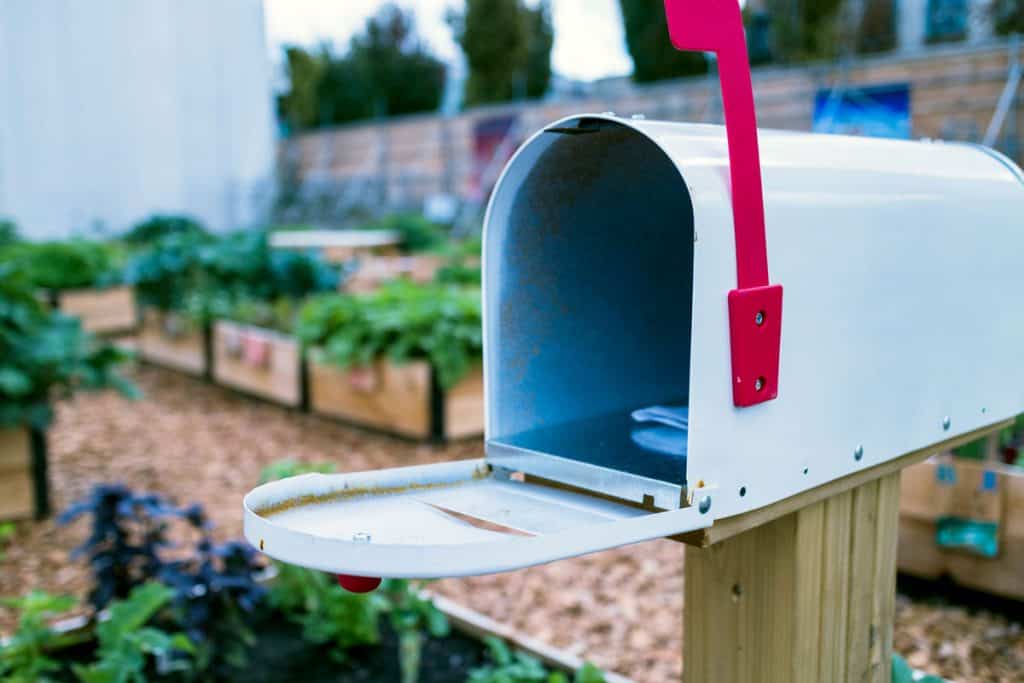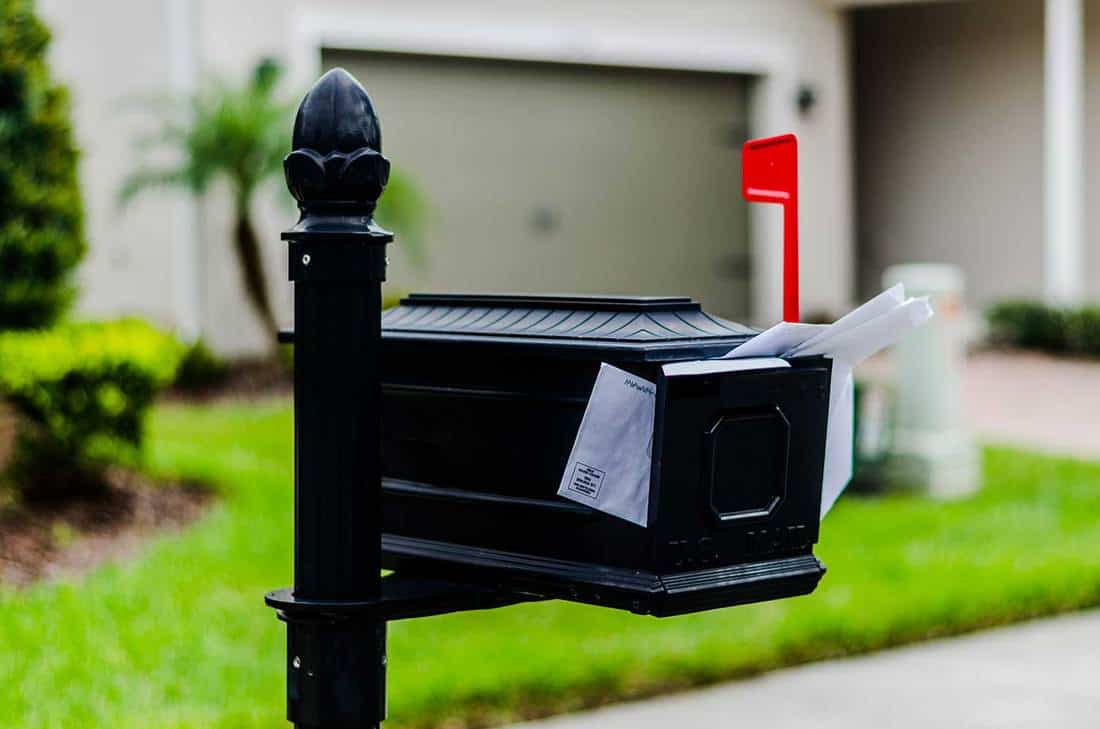Perhaps a vehicle took out your current mailbox, or maybe you just want to relocate your mailbox to a better spot. Regardless, you can rest assured that this project is suitable for even novice DIYers. One of the most critical topics to address before getting started is the depth of the post. So, how deep should a mailbox post be? For your convenience, we brought you the answer.
In general, approximately 1/3 of the post should be in the ground. This means that a typical mailbox post should be set 20-24 inches into the ground. This is the perfect depth for optimal stability.
If you still have some questions about how deep to set a mailbox post, don't worry. In this guide, we'll discuss the topic in greater detail. We'll also talk about whether or not a mailbox post should be set in concrete, how much concrete is needed for the project, how to use Quikrete to set a mailbox post, and more. Without further ado, let's get into it!
![Black mailbox on the side of the street, How Deep Should A Mailbox Post Be? [A Complete Guide]](https://homedecorbliss.com/wp-content/uploads/2021/06/How-Deep-Should-A-Mailbox-Post-Be-A-Complete-Guide0000-1024x683.png)
The Optimal Mailbox Post Depth
We sometimes add affiliate links and content that was curated and created by our team with the help of advanced ai tools to help showcase the best design styles.

20-24 inches (or approximately 1/3 of the post) is the optimal depth for a mailbox post for a couple of reasons.
First, this depth ensures adequate stability. From a physics standpoint, the deeper a vertical object is anchored into the ground the more stable it will be, and this is certainly true with mailbox posts.

But at the same time, you don't want the mailbox post to be too deep. If you dig too deep you might rupture pipes, wires, or other lines running underground, and nobody wants that. What's more, setting a mailbox post too deep will make it significantly more difficult to remove later on should you need to replace it or reposition it.
Should A Mailbox Post Be Set In Concrete?

A mailbox should definitely be set in concrete. While it is possible to set the post without it, concrete will hold it securely in place for years (or even decades). Mailboxes are subjected to all kinds of abuse, from inclement weather to foundational shifting, and concrete is the best way to protect the mailbox post from these conditions.
How Much Concrete Do I Need For A Mailbox Post?
60 pounds of concrete should suffice to set a mailbox post 20-24 inches into the ground. However, you might need less or more depending on the thickness of the post and the diameter of the hole.

How Do You Use Quikrete For A Mailbox Post?
Quikrete concrete mix is by far one of the best ways to set a mailbox. To do so, simply follow these steps:
- Dig the post hole. Ensure that the hole is 20-24 inches deep, and ensure that the diameter of the hole is approximately three times the width/diameter of the post.
A post hole digger makes the job quick and easy.
Click here to see this post hole digger on Amazon.
- Add six inches of Quikrete All-Purpose Gravel into the hole.
- Place the post in the hole, and use a post level tool (more on that later) to ensure that the post is perfectly level.
- Fill the remainder of the hole with Quikrete Fast-Setting Concrete Mix up to about three to four inches below the ground.
- Pour a gallon of water into the hole, and give it enough time to sufficiently saturate the concrete. After 20 to 40 minutes, the concrete should be set. However, it's recommended to wait at least four hours before applying significant weight or pressure to the post.
For a visual guide to using Quikrete, check out this video tutorial:
How Do I Keep My Post Level While The Concrete Dries?
Keeping the post level is critical. There are a few things to consider to ensure that your mailbox post stays level until the concrete dries.
Use A Post Level Tool
Trying to get the post level (and ensuring that it remains level until the concrete sets) is undoubtedly one of the most frustrating parts of the process. Keeping the post level is particularly difficult with a conventional one-axis level.
Using a post level is a great way to ensure that the post stays level while the concrete dries. A post level allows you to easily tell whether or not all dimensions of the post are level. Anyone that has set a post with a conventional level can attest to the fact that it's a painstaking process.
Click here to see this post level tool on Amazon.
Keep Weight And Pressure Off The Post While The Concrete Dries
In addition to ensuring that the post is level, it's important to ensure that the post remains free of weight and pressure while it sets. Concrete takes several hours to completely dry, and even slight pressure placed on the post while the concrete dries can cause it to become unlevel.
Don't Put Pressure On The Post To Check The Concrete
A common tendency to confirm that the concrete is set is to try to shake the post. You can certainly do so once you are certain the concrete has set completely. But before then, it's important to check the concrete in a way that won't compromise the post should the concrete still be wet.

So, when it's time to check the concrete to see if it's dry, simply touch the concrete. If it feels wet and/or has any give to it, it hasn't completely set. If the concrete is totally dry and firm, the concrete has set, and you're ready to proceed with the project.
What Is The Best Material For A Mailbox Post?
When it comes to mailbox posts, metal, wood, and vinyl/plastic are the most common materials used, and there is a good case to be made for each.
Metal

Metal mailbox posts are generally impervious to weather. Aside from the possibility of rust, metal posts are sure to stand the test of time.
Wood

Wooden posts are resistant to weather, but over time they will deteriorate. However, wood is generally more customizable in terms of aesthetics. Wooden mailbox posts can be stained or painted to your liking to work well with your home's aesthetic.
Vinyl/Plastic

Vinyl/plastic mailbox posts are also highly weather-resistant; these posts are common in northern areas that experience heavy seasonal freezing. From a visual standpoint, vinyl/plastic mailbox posts can seamlessly fit in with a home's aesthetic.
In Closing
We hope this guide helped you better understand why the optimal depth for a mailbox post is 20-24 inches. This depth will provide optimal stability, ensuring that your mailbox remains firmly in place for decades. If you heed the tips mentioned here, the project will be a breeze.
Before you go, be sure to check out these other guides that might be of interest:
How To Attach Wood Framing To Concrete [4 Steps To Follow]
How Thick Should A Concrete Driveway Be?
Should You Seal Your Concrete Driveway? [A Thorough Look At Pros And Cons]
![Mailbox outside of an American house, How Deep Should A Mailbox Post Be? [A Complete Guide]](https://homedecorbliss.com/wp-content/uploads/2021/06/How-Deep-Should-A-Mailbox-Post-Be.png)


